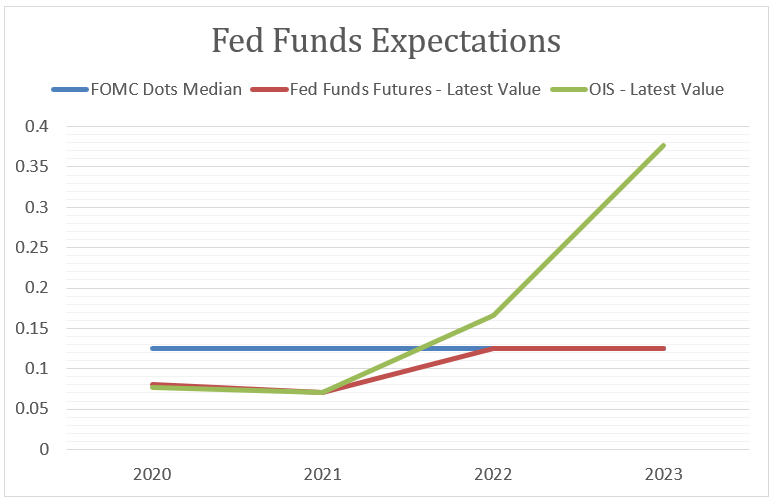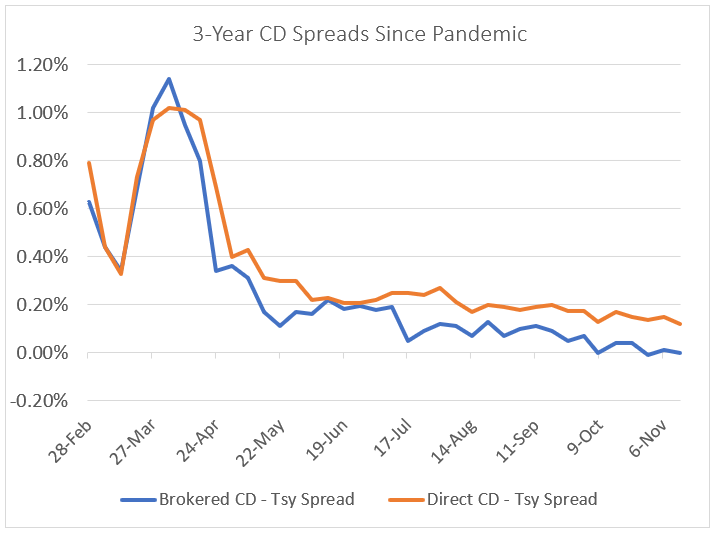CDs have long been the bedrock of credit union investment portfolios, particularly for small and medium-sized institution.
This emphasis on CDs is understandable given the FDIC and NCUSIF insurance coverage, ease of access, and straight-forward analysis that they offer. However, the Fed Funds rate outlook and influx of liquidity are rendering the CD market un-investable for many credit unions.
This article will identify the factors that are currently impacting the CD market and the alternatives that may help credit unions insulate investment income.
Fed Funds Expectations Are Driving CD Yields Lower

The CD market pays minimal credit spread above the risk-free rate due to the government insurance coverage provided on the first $250 thousand on deposit. While brokered CDs are often assigned CUSIPs and have active secondary markets, direct placement CDs are typically less liquid and subject to early redemption penalties. As a result, direct placement CDs often receive some additional spread for the lack of liquidity.
In either case, the current forward guidance from the Fed indicates they plan to keep interest rates near zero for the next three-five years. The risk-free rate remains anchored within the current Fed Funds target range of 0-0.25% for tenors out to three years in maturity. Further out the curve, yields are stuck below 1% at the 10-year tenor due to low inflation expectations.
Impact of COVID-19 Pandemic Recession
The COVID-19 pandemic resulted in dramatic changes to credit union balance sheets. Practically all institutions have a surplus of deposits as a result of fiscal stimulus and higher savings rates.
According to CUNA Mutual data as of September 30th, national credit union savings balances are up over 18% year-over-year. The same data also shows that loan-to-assets ratios are down to 65% from a peak of 72% in late 2018.
This creates ample low-cost funds on the balance sheet that can fund loan opportunities. This minimizes the need to tap the wholesale CD market to fund the balance sheet. With fewer issuers, supply and demand economics apply. Issuers therefore have little incentive to offer rates much higher than the Fed Funds target range.
Relative Value
There are more attractive opportunities for credit union investors in other permissible asset classes.
Lastly, the CD market has become un-investable on a relative value basis. CD spreads over Treasury bonds have evaporated since the start of the pandemic.
As illustrated along the left axis of the graph below, prior to the onset of the pandemic, direct placement CDs could be found at spreads of around 80 basis points over Treasury bonds. As of early November, Brokered CDs offer no yield advantage relative to Treasury bonds and direct placement CDs only pick up an estimated 15 basis points.

Insulate Investment Income
The current outlook for interest rates and rising deposits on balance sheets mean CDs will not be drivers of investment income any time soon. But it’s not necessary to scrap them entirely from the credit union’s investment strategy. Rather, CDs should be utilized as short-term cash alternatives matched to near-term net loan growth needs.
To insulate downward pressure on investment income, credit union investors will need to look to the Agency debenture and Agency mortgage-backed security market in order to preserve investment income. Additionally, once a well-managed Agency MBS/CMO portfolio is implemented it produces amortizing cashflows that resemble a CD-ladder, but at a higher yield.
Alternative at the 3-year tenor: US Agency Bullets
These are option-free bonds issued by government-sponsored enterprises. They offer yields that are equal to or better than CD offerings while also offering improved liquidity and scalability.
Alternative for longer duration investments: Agency CMOs
For longer duration investments, we are regularly seeing well-structured Agency collateralized mortgage obligations (CMOs) with base case yields between 0.70 to 1% for 3 to 5-year weighted average lives.
Developing Your Credit Union’s Investment Strategy
Changing your investment strategy can be daunting. Navigating new asset classes and the changing market conditions may impose a steep learning curve. Some asset classes even require professional analysis beyond the resources available at many credit unions.
By JD Pisula